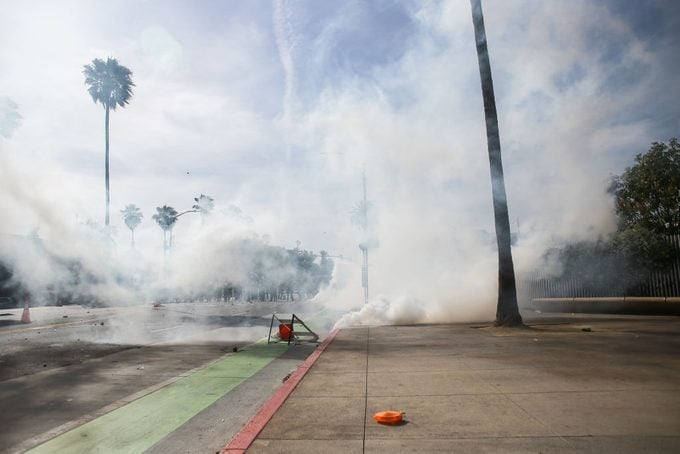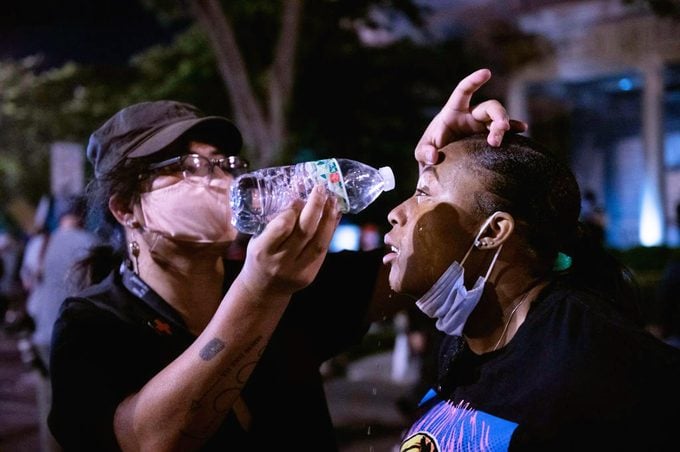Here’s What Happens to Your Body When You’re Tear Gassed—and What to Do
Updated: Mar. 14, 2022
Tear gas affects pain receptors in the eyes, skin, and respiratory tract, causing symptoms like coughing, burning eyes and mouth, and nausea.
 Law enforcement personnel have been using tear gas to quell demonstrators protesting the death of George Floyd in the custody of Minneapolis police officers. It is a particularly effective weapon for crowd control because it causes so much irritation to the eyes and mucous membranes. “You can’t go forward,” says Robert Glatter, MD, an emergency physician in New York City. “You have to stop.”
Law enforcement personnel have been using tear gas to quell demonstrators protesting the death of George Floyd in the custody of Minneapolis police officers. It is a particularly effective weapon for crowd control because it causes so much irritation to the eyes and mucous membranes. “You can’t go forward,” says Robert Glatter, MD, an emergency physician in New York City. “You have to stop.”
Because tear gas is an “indiscriminate” weapon, in the words of the American Civil Liberties Union (ACLU), it can harm more people than just active protesters. People living near the protests in Denver have reported tear gas leaking into apartments as high as the sixth floor. The New York Times has reported that the respiratory effects of tear gas may also worsen the spread of Covid-19, by causing increased coughing.
What is tear gas, how can you protect yourself and what should you do if you’re exposed?
What is tear gas?
Also known as a “riot control agent,” tear gas is technically not a gas. “It’s actually a powder, but it’s suspended in liquid or solvent and it’s in a pressurizing canister, so when it gets expelled, it looks like gas,” says Dr. Glatter.
“There are a couple of different types of tear gas,” says Leigh Vinocur, MD, a spokesperson for the American College of Emergency Physicians (ACEP). According to the Centers for Disease Control and Prevention (CDC), the more common ones contain chloroacetophenone (CN) or chlorobenzylidenemalononitrile (CS). Another one contains capsaicin, the compound in pepper spray, says Dr. Vinocur
Tear gas can be deployed in various ways, including canisters and spray devices, says Ian Wittman, MD, chief of emergency medicine at NYU Langone Hospital–Brooklyn.
What does tear gas do to your body?
Once tear gas has been released into the air, it can irritate your skin and your eyes as well as your mouth and throat, says the CDC. The gas usually starts working within a few seconds, and the effects can last up to an hour, says Dr. Glatter.
Tear gas affects pain receptors in the eyes, skin, and in the respiratory system, says Dr. Vinocur. So symptoms can include coughing and choking, blurry vision, eye spasms (blepharospasm), runny nose, burning mouth, salivating, wheezing, burning and itching skin, as well as nausea and vomiting, says the CDC.
One protester told the Washington Post, “[Y]our throat burns. Your eyes burn. Your chest burns. Your skin burns. You can’t see. Everything is so blurry. . . The pain is—there are no words. I’ve never experienced anything like it to compare it to.”
The biggest threat is actually from the canister that launches the gas, says Dr. Wittman. “This is a missile projectile and it can cause significant injuries,” he says. “People have had damage to the eyes, eyes removed, broken bones.”
Are certain people at higher risk from tear gas?
People with underlying lung disorders like asthma and COPD are potentially at a higher risk for shortness of breath. There’s also the chance the existing disorder could be worsened, says Dr. Wittman. This is especially true if the tear gas is released in a closed environment. “That’s much more dangerous than outdoors, where it tends to disperse quickly and people typically can leave area relatively quickly,” he adds.
Children, too, are at higher risk, especially for respiratory problems, notes Dr. Glatter.
Some people who have recovered from Covid-19 may have suffered permanent respiratory damage, which could be exacerbated by tear gas. says Dr. Vinocur. (If you have Covid-19 or think you do, you definitely should not be in crowds.)
Any respiratory damage from tear gas could also make a person more vulnerable to catching Covid-19.

Can there be long-term damage?
Yes. This may include blindness, glaucoma, cataracts, and scarring in the eyes, asthma, and even respiratory failure, says the CDC.
“There have been cases that some people get elevated blood pressure after inhaling tear gas that can cause a stroke or heart attack, but this is not common,” says Dr. Glatter.
Two groups—Physicians for Human Rights and the International Network of Civil Liberties Organizations—conducted a survey of 31 studies on crowd-control weapons such as tear gas that were published between 1990 and 2015 and involved more than 5,000 people. The report revealed that two people who were exposed to tear gas died (including one from being hit by a canister) and 70 people (1.7 percent) had permanent damage, including blindness, traumatic brain injury, and limb amputation. That report also found long-term psychiatric symptoms in 14 people.
What do do if you’ve been exposed
Leave the area. If you’re inside, move outside. If you’re outdoors, find higher ground. “The gas is actually heavier than air and sinks lower,” explains Dr. Glatter. “The higher ground you are on, the better off you are.”
The CDC says you should also take off any contaminated clothing (cut it off rather than pull it over your head) as well as any jewelry. Dispose of the clothing in double, sealed plastic bags.
Douse your eyes with water and saline, if you have it, advises Dr. Wittman. Don’t rub your eyes, stresses Dr. Vinokur and, importantly, if you’re wearing contact lenses, take them out immediately. If your eye symptoms don’t return to normal in 15 to 30 minutes, get medical help, Dr. Wittman adds.
There’s no evidence that baby shampoo or milk help, Dr. Wittman says.
In addition to getting away from the source of exposure, asthma medications like bronchodilators and steroids—which open up the airways— be helpful to someone who has been tear-gassed, says the CDC.
Are there ways to protect myself?
You can protect your eyes by not wearing contact lenses to a protest and having a large bottle of water (some to drink, more to splash your eyes if you’re exposed), says Dr. Wittman. Glasses can potentially help, as can goggles, though the tear gas will likely leak around them.
And take your own towel to wipe (not rub) your eyes. “Try not to share them with others, especially with Covid-19,” says Dr. Wittman. “They could potentially spread infections.”
